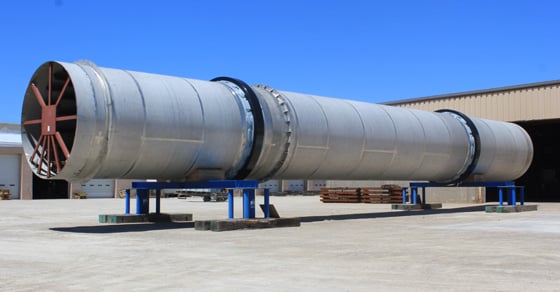Rotary dryers are essential to many bulk solids processing and handling operations, reducing the moisture content of both raw materials and finished products.
About Rotary Dryers
Rotary dryers use a tumbling action in combination with a drying air in order to efficiently dry materials. Most often, these robust industrial dryers are of the direct-fired type, meaning that the drying air is in direct contact with the material. Some dryers, however, are of the indirect configuration, whereby the dryer is heated externally, to avoid direct contact between the material and the drying air.
Rotary dryers are comprised of a rotating drum, into which the material is fed, in combination with the drying air. Flights, or material lifters, pick up the material from the bed, carrying it over, and dropping it through the air stream to maximize heat transfer between the material and drying air.
Material is processed for a specified amount of time, referred to as the retention time, at the desired temperature, in order to reach the target moisture content.
While rotary dryers are available in standardized models, designing a rotary dryer around the unique characteristics of the material and process needs will produce the best results and offer the most reliability. Various aspects of the dryer are considered during initial design in order to reach the exact desired parameters of the end product.
Rotary Dryer Construction
While FEECO rotary dryers are custom designed around the material to be processed, the basis of a rotary dryer is somewhat standard, with customizations coming in terms of sizing, materials of construction, mechanical components, and add-ons, among other items. These components are described here.
Shell:
The rotary dryer shell can be made from a variety of materials, including carbon steel, stainless steel, hastelloy, Inconel, and a variety of other alloys. The shell may also be customized in different ways, depending on the needs of the material and the process. For example, shell thickness can be adjusted for situations where heat retention inside the dryer is of the utmost importance. The shell may also be insulated in order to aid in retaining heat.
Manufacturing techniques are vital on the shell, which must run true and concentric in order to work properly. A poorly manufactured drum will promote wear on all components and reduce equipment efficiency and longevity.
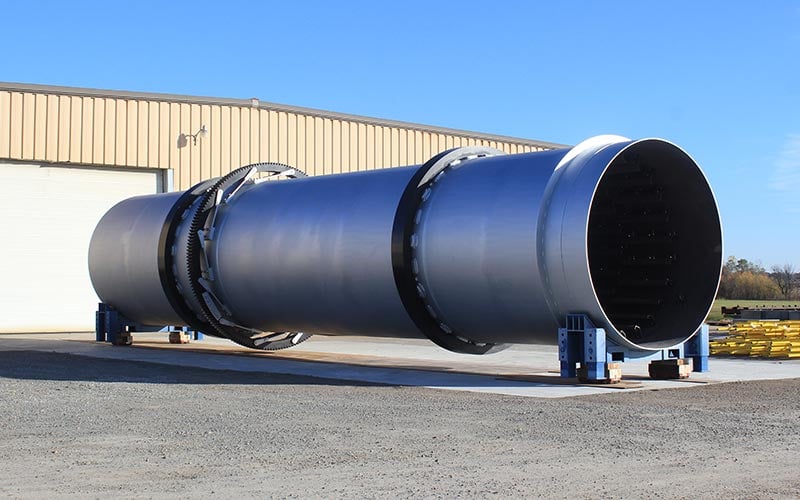
Rotary dryer shell with riding rings and ring gear
The Combustion Chamber:
The combustion chamber houses the actual combustion reaction and directs the airflow of the rotary dryer. Combustion chambers can be integrated into either co-current (airflow in direction of material flow) or counter-current dryers. The goal with a combustion chamber is to keep the material from coming into direct contact with the burner flame. Not all rotary dryers require a combustion chamber, but they can offer many benefits. See our article: Rotary Dryers: When is a Combustion Chamber Necessary for more information.
A variety of combustion chambers are available, with customizations ranging from single or double shell, to refractory lined, and angled. Combustion chambers can also accommodate a wide variety of burners. Finding a quality combustion chamber is important to the quality of the product, and the energy consumed to get to the end product. When a low-quality combustion chamber is used, many problems can result, from inefficiency, to product breakdown, and in some cases, a short combustion chamber lifespan.
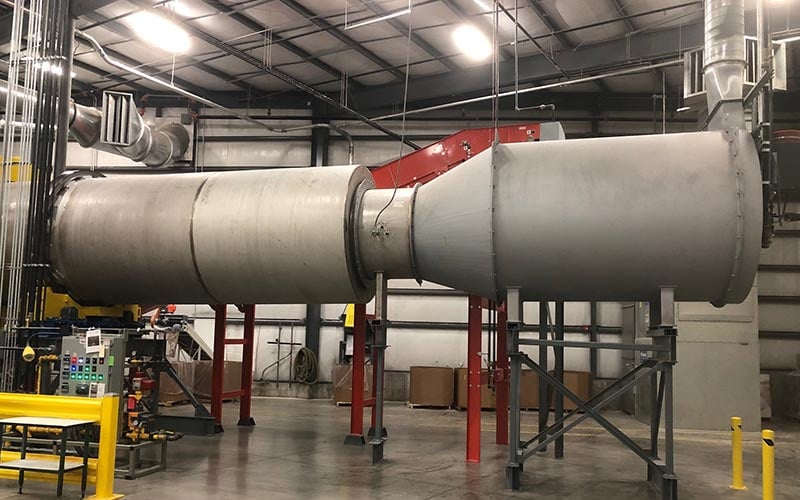
Combustion chamber on a rotary dryer
Burner:
The burner is the engine behind any dryer, determining the output of BTU’s/Watts. Burners can be designed for a multitude of fuel sources, including natural gas, propane, diesel, and more. Choosing the appropriate burner specifications is essential for proper and efficient drying of the material.
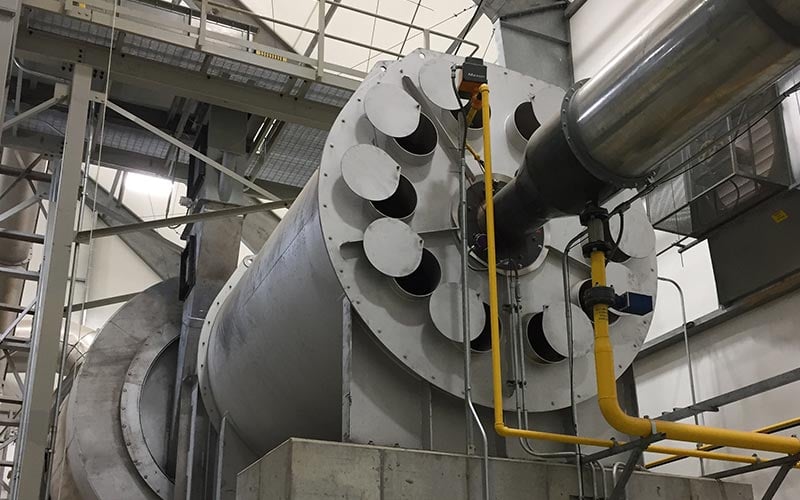
Burner on a combustion chamber
Raw Material Feed:
The raw material feed area, also called the feed chute, is where feedstock is fed into the system, typically by a feed screw or chute. The feed chute is specifically designed to be robust, resistant to wear, and to reduce material build-up.
Air Seal
Where the combustion chamber and discharge breeching meets the drum, a seal is needed to connect the stationary component to the rotating drum. The purpose is to keep air and material from leaving the drum prematurely, and more importantly, to prevent air from leaking into the unit and decreasing process efficiency. Many different seal options exist, again, depending on the needs of the material being processed.
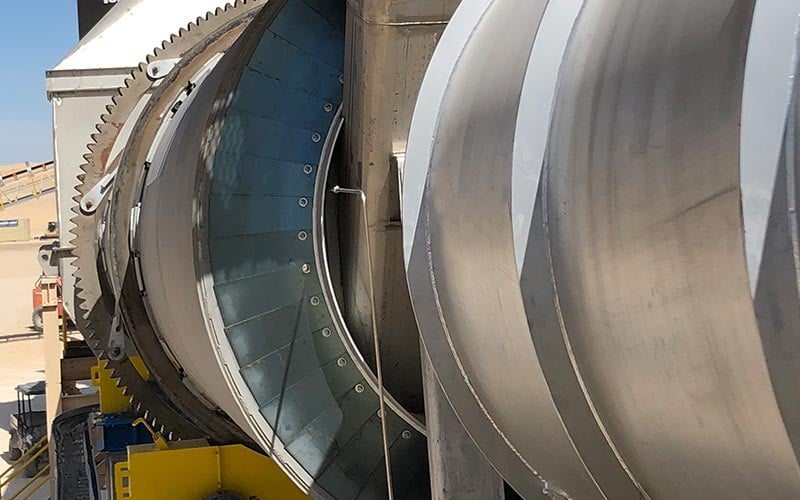
Leaf seal on a rotary dryer
Drive Assembly
The drive assembly is the mechanism that causes the drum to rotate. Several options are available: a chain and sprocket, gear and pinion, friction drive, or direct drive setup.
A chain and sprocket setup is ideal for smaller rotary drums, running up to 75 horsepower, while gear and pinion drive assemblies are reserved for more heavy-duty applications, running above 75 horsepower. A reducer decreases the speed of the motor for higher torque applications with both drive assembly types.
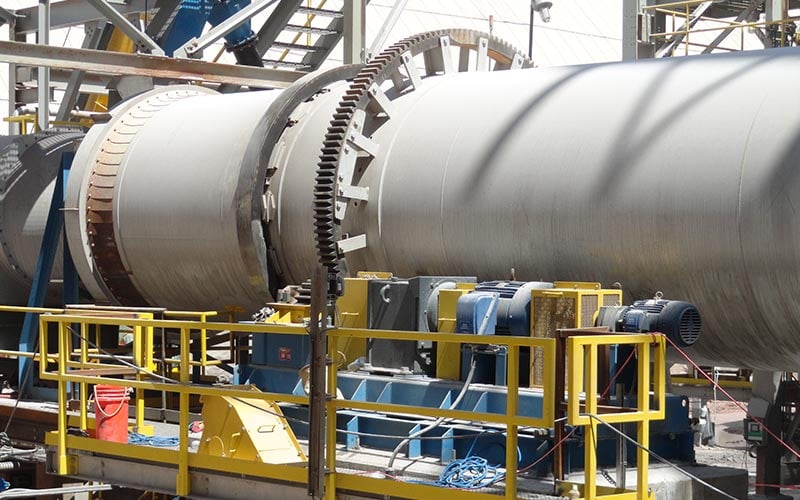
Rotary dryer with gear and pinion drive assembly
Friction drive assemblies are used for very small drums with low horsepower, typically drums around 6’ and under. In this setup, two of the four trunnion wheels are connected by one shaft and driven by a shaft-mounted reducer and motor arrangement.
The direct drive setup is used for small-to-medium size drums with motor sizes up to 75 horsepower. The design consists of a shaft mounted to a solid, discharge end plate at the outlet of the dryer. The motor and reducer are either directly connected to this shaft with a coupling, or a shaft mount arrangement.
Riding Ring
Riding rings add structural support to the drum and serve as a place for pressure to be absorbed, riding ron the trunnion wheels/rollers.

Rotary dryer tire (riding ring)
Thrust Rollers
Thrust rollers push on the riding ring to stop the drum from drifting, or moving longitudinally.
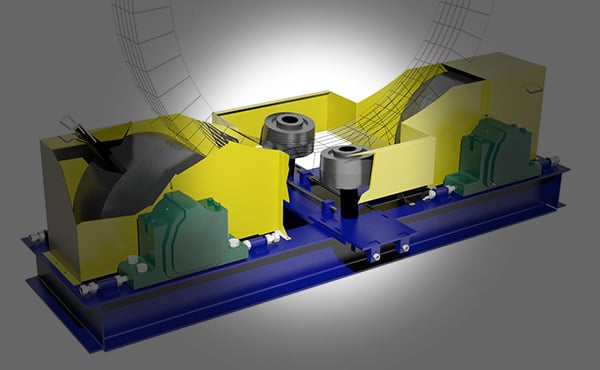
3D Rendering showing thrust roller placement
Trunnion Wheels
The trunnion wheels act as the cradle for the rotating drum shell. They ensure smooth and concentric rotation during operation. They also act as a wear piece, since they are cheaper and easier to replace than the riding rings. The wheels are mounted to steel support bases with sealed roller bearings. Trunnion rollers bear the weight of the drum.
Flights
Available in several designs, material lifters, or flights, help to maximize efficiency of heat transfer between the material and the drying air. Flights pick up material, carry it over, and shower it through the air stream as the drum rotates, promoting efficient heat transfer between the material and drying air. Both flight design and pattern are customizable.
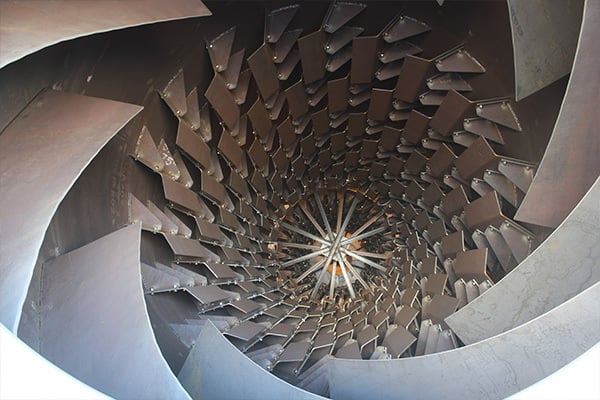
Flights in a rotary dryer; spiral/advancing flights can also be seen
Product Discharge
The product discharge area is where product exits the dryer. Here, product can move on to the next step in the process flow. A rotary cooler may follow the dryer in order to cool the material for packaging or storage.
Discharge Breeching
The discharge breeching is where two main functions occur: product exits the dryer, moving on to screening, cooling, storage, or shipping, and the exhaust gas system removes off-gases from the system. Exhaust gas systems provide a place for spent gases and hot air (and small particulates) to exit the system. Exhaust gas and particulates typically then go on to a scrubber or bag house to remove contaminants before being discharged into the atmosphere.
Common Add-Ons
Advancing Flights
Advancing flights help to advance material into the drum, in order to prevent buildup near the wet feed discharge. Incorporating advancing flights into a rotary dryer also gives material a chance to dry before it reaches the next flights, a process which can help prevent potential sticking issues.
Knocking Systems
Knocking systems help to prevent build-up within the dryer, by “knocking off” material as the drum rotates. Various options are available for knocking systems. For more information on knocking systems, see our Knocking Systems Brochure.
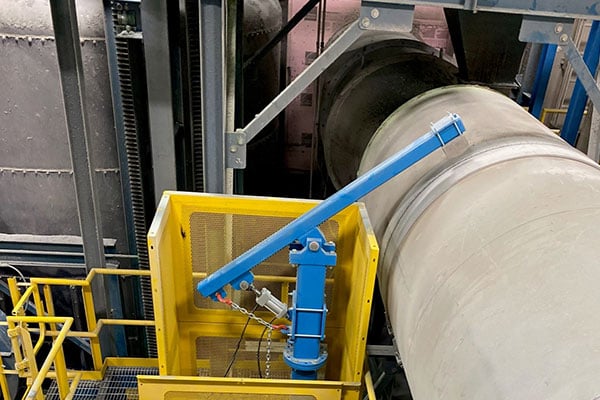
Trommel Screens
A trommel screen, also known as a “grizzly,” can be fitted onto a rotary dryer to help break up any clumps that may have formed in the dryer.
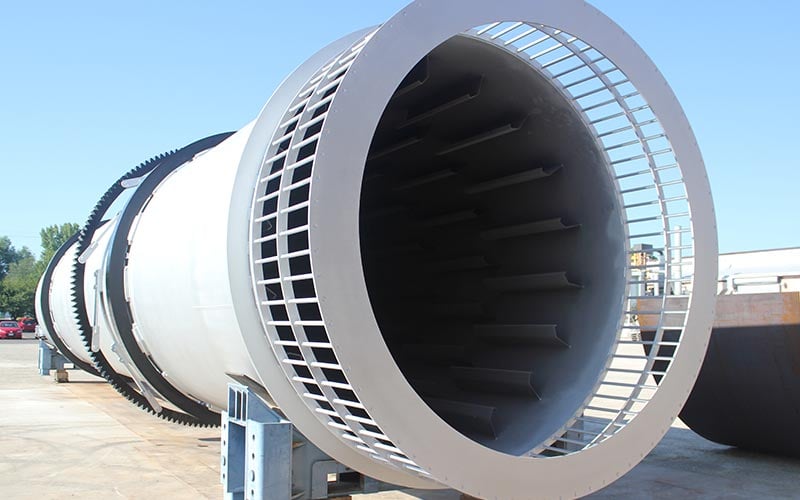
Trommel screen (grizzly) on a rotary dryer
For more information on our custom rotary dryers, contact us today!



